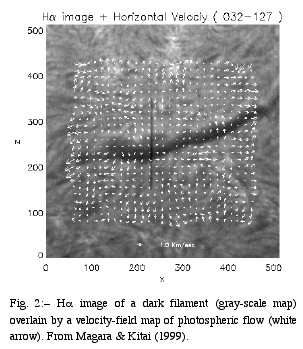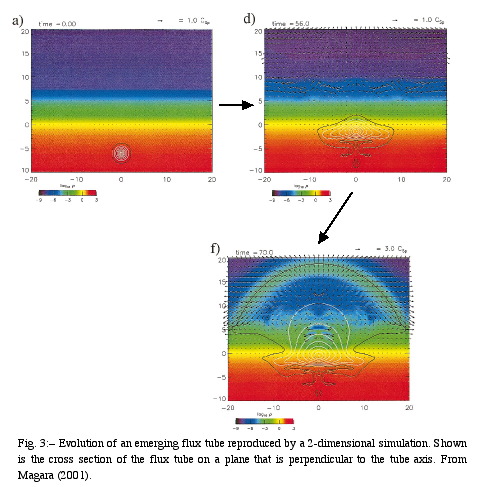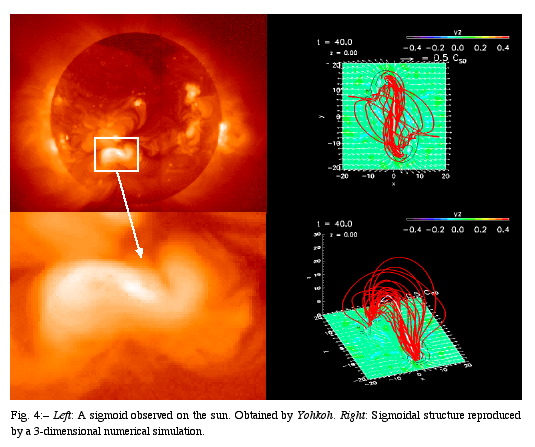Research Experiences & Interests
 When I was a graduate student
at Kyoto Univerisity
(1993 - 1997) I studied solar flares with focus on the dynamic aspect
of flares. Flares are a transient phenomenon on the sun,
releasing a huge amount
of energy and sometimes causing a dramatic change of coronal structure.
Detailed observations of
flares are necessary for
the understanding of the physical processes of flares.
In my case,
the satellite Yohkoh
(1991 - 2001) made a lot of contributions to my study by providing
the key information of solar plasma driving a flare,
such as cusp-shaped loops,
eruptive plasmoids, and loop-top sources.
When I was a graduate student
at Kyoto Univerisity
(1993 - 1997) I studied solar flares with focus on the dynamic aspect
of flares. Flares are a transient phenomenon on the sun,
releasing a huge amount
of energy and sometimes causing a dramatic change of coronal structure.
Detailed observations of
flares are necessary for
the understanding of the physical processes of flares.
In my case,
the satellite Yohkoh
(1991 - 2001) made a lot of contributions to my study by providing
the key information of solar plasma driving a flare,
such as cusp-shaped loops,
eruptive plasmoids, and loop-top sources.
 Owing to its high spatial and temporal resolutions
compared to previous satellites,
Yohkoh has given us
a lot of images showing rapid evolution of flares,
which acutually prompted me to study the dynamic
aspect of flares. In order to make a good comparison between theory
and observation, I performed
multi-dimensional numerical simulations
which help us incorporate the
nonlinear evolution of solar plasma into a flare model.
Owing to its high spatial and temporal resolutions
compared to previous satellites,
Yohkoh has given us
a lot of images showing rapid evolution of flares,
which acutually prompted me to study the dynamic
aspect of flares. In order to make a good comparison between theory
and observation, I performed
multi-dimensional numerical simulations
which help us incorporate the
nonlinear evolution of solar plasma into a flare model.
Flares have been an important object of study in the solar physics
for a long time, so several theoretical models have been
proposed to explain observed nature
of flares.
The subject of
my Ph.D. thesis
is to develop a flare model known as
'CSHKP model' based on the new results
obtained by
Yohkoh.
Yohkoh discovered that an energetic source
is formed at the top of a soft X-ray coronal loop (loop-top source) not only
in LDE (Long Duration Event) flares but also in impulsive flares.
By performing MHD numerical simulations, I investigated
how the loop-top source is formed and maintained during a flare.
(Magara et al. 1996; figure 1).
Yohkoh also
used high temporal resolution to observe a plasmoid erupting into the
interplanetary space in several flares.
Based on this result, we
studied the driving mechanism for plasmoid eruption
(Magara, Shibata, and Yokoyama 1997, Magara and
Shibata 1999).
The main phase of flares during which a sufficient amount of energy is
released
has been drawing my scientific curiosity,
while I am also interested in the preflare phase during which
the energy
is accumulated. After taking a doctor degree
of physics from
Kyoto University, I moved to
Hida Observatory (1998 - 2000), where I studied photospheric gas motions
around a dark filament because
these motions have been suggested to play an important role
in building up free energy.
By applying LCT
(Local Correlation Tracking) method to a time series of G-band data,
I obtained maps of photospheric velocity field which were then
compared to Halpha images of the filament
(Magara and Kitai 1999; figure 2).
This kind of photospheric velocity map is
useful in the sense that it
gives a photospheric boundary condition of numerical simulations
whereby
we can tell how coronal structure evolves in response to
photospheric motions.
 Magnetic flux emergence is also an important subject of my researches,
which carries a bunch of magnetic fields from the solar interior to the solar
atmosphere.
It has been suggested that magnetic field forms a bundle
of slender flux tubes below the photosphere and when
these flux tubes
emerge into the atmosphere they start to expand dynamically
because the gas pressure surrounding the flux tubes decreases abruptly
across the photosphere. In order to investigate these highly dynamic
processes, MHD numerical simulation has proven to be a useful tool.
It reproduces the dynamic nature of
flux emergence in which magnetic field experiences a rapid
transition
from confined state to expanded state. I first studied
the two-dimensional evolution of flux emergence
(Magara 2001; figure 3),
then developed a three-dimensional numerical code to study
flux emergence in more general environment. These studies
reveal various aspects of flux emergence,
such as the formation of sigmoidal structure in the corona
(Magara and Longcope 2001, Magara 2004;
figure 4), injection of magnetic energy and magnetic
helicity into the atmosphere (Magara and Longcope 2003), and dynamic nature
of emerging field lines (Magara 2004).
Magnetic flux emergence is also an important subject of my researches,
which carries a bunch of magnetic fields from the solar interior to the solar
atmosphere.
It has been suggested that magnetic field forms a bundle
of slender flux tubes below the photosphere and when
these flux tubes
emerge into the atmosphere they start to expand dynamically
because the gas pressure surrounding the flux tubes decreases abruptly
across the photosphere. In order to investigate these highly dynamic
processes, MHD numerical simulation has proven to be a useful tool.
It reproduces the dynamic nature of
flux emergence in which magnetic field experiences a rapid
transition
from confined state to expanded state. I first studied
the two-dimensional evolution of flux emergence
(Magara 2001; figure 3),
then developed a three-dimensional numerical code to study
flux emergence in more general environment. These studies
reveal various aspects of flux emergence,
such as the formation of sigmoidal structure in the corona
(Magara and Longcope 2001, Magara 2004;
figure 4), injection of magnetic energy and magnetic
helicity into the atmosphere (Magara and Longcope 2003), and dynamic nature
of emerging field lines (Magara 2004).
The following is a list of my current research interests.
- Interaction between an emerging flux tube and
preexisting coronal field
In the past I investigated the evolution of a single flux tube emerging into the corona where there is no magnetic field outside the flux tube. However the interaction between the emerging flux tube and preexisting coronal field is very important for studying various activities on the sun, such as X-ray bright points, flares, filament eruptions, and CMEs (coronal mass ejections). movie
- Waves generated by an eruptive plasmoid

A plasmoid ejected from the sun forms various kinds of waves in the solar atmosphere, including strong shock waves. It is interesting to study the relation between these plasmoid-driven waves and various observed waves such as Moreton
waves, EIT waves, and coronal type II radio bursts (Magara et al. 2000).
- Formation of three-dimensional coronal current sheets
A three-dimensional current sheet appears in the intermediate region
between different magnetic domains, showing much more complicated
structure than a two-dimensional current sheet.
Clarifying the formation process of 3D current sheets is important
for predicting when and where energetic events
occur in the corona (Longcope and Magara 2004).
- What makes a filament active? (Space Weahter)
This topic is related to the initiation of CMEs and therefore it is important
for space weather. It is my deep interest to understand
coronal and photospheric magnetic configurations leading to filament eruption.
- Thermodynamical evolution of coronal loops
Flux emergence simulations have demonstrated
that emerging magnetic field expands
into the solar atmosphere, forming the skeleton of coronal magnetic structure.
The next step of this study is to understand how some portions of
the coronal structure are illuminated to appear as bright coronal loops,
which requires the detailed knowledge of thermodynamical processes in
individual coronal loops.
References
Magara, T. 2004
ApJ, 605, 480
"A Model for Dynamic Evolution of Emerging Magnetic
Fields in the Sun"
movie
Longcope, D. W. & Magara, T. 2004, ApJ, 608, 1106
"A Comparison of the Minimum Current Crona to a Magnetohydrostatic
Simulation of Quasi-static Coronal Evolution"
Magara, T. & Longcope, D. W. 2003, ApJ, 586, 630
"Injection of Magnetic Energy and Magnetic Helicity into the Solar Atmosphere by an Emerging Magnetic Flux Tube"
Magara, T. & Longcope, D. W. 2001, ApJ, 559, L55
"Sigmoid Structure of an Emerging Flux Tube"
Magara, T. 2001, ApJ, 549, 608
"Dynamics of Emerging Flux Tubes in the Sun"
Magara, T., Chen, P. F., Shibata, K.,
& Yokoyama, T. 2000, ApJ, 538, L175
"A Unified Model of Coronal Mass Ejection-related
Type II Radio Bursts"
Magara, T. & Kitai, R. 1999, ApJ, 524, 469
"Photospheric and Chromospheric Gas Motions around a Dark Filament"
Magara, T. & Shibata, K. 1999
ApJ, 514, 456
"Evolution of Eruptive Flares. II.
The Occurrence of Locally Enhanced Resistivity"
Magara, T., Shibata, K., & Yokoyama, T. 1997, ApJ, 487, 437
"Evolution of Eruptive Flares. I. Plasmoid Dynamics in Eruptive Flares"
Magara, T., Mineshige, S., Yokoyama, T., & Shibata, K. 1996, ApJ, 466, 1054
"Numerical Simulation of Magnetic Reconnection in Eruptive Flares"

 When I was a graduate student
at Kyoto Univerisity
(1993 - 1997) I studied solar flares with focus on the dynamic aspect
of flares. Flares are a transient phenomenon on the sun,
releasing a huge amount
of energy and sometimes causing a dramatic change of coronal structure.
Detailed observations of
flares are necessary for
the understanding of the physical processes of flares.
In my case,
the satellite Yohkoh
(1991 - 2001) made a lot of contributions to my study by providing
the key information of solar plasma driving a flare,
such as cusp-shaped loops,
eruptive plasmoids, and loop-top sources.
When I was a graduate student
at Kyoto Univerisity
(1993 - 1997) I studied solar flares with focus on the dynamic aspect
of flares. Flares are a transient phenomenon on the sun,
releasing a huge amount
of energy and sometimes causing a dramatic change of coronal structure.
Detailed observations of
flares are necessary for
the understanding of the physical processes of flares.
In my case,
the satellite Yohkoh
(1991 - 2001) made a lot of contributions to my study by providing
the key information of solar plasma driving a flare,
such as cusp-shaped loops,
eruptive plasmoids, and loop-top sources.
 Owing to its high spatial and temporal resolutions
compared to previous satellites,
Yohkoh has given us
a lot of images showing rapid evolution of flares,
which acutually prompted me to study the dynamic
aspect of flares. In order to make a good comparison between theory
and observation, I performed
multi-dimensional numerical simulations
which help us incorporate the
nonlinear evolution of solar plasma into a flare model.
Owing to its high spatial and temporal resolutions
compared to previous satellites,
Yohkoh has given us
a lot of images showing rapid evolution of flares,
which acutually prompted me to study the dynamic
aspect of flares. In order to make a good comparison between theory
and observation, I performed
multi-dimensional numerical simulations
which help us incorporate the
nonlinear evolution of solar plasma into a flare model.
 Magnetic flux emergence is also an important subject of my researches,
which carries a bunch of magnetic fields from the solar interior to the solar
atmosphere.
It has been suggested that magnetic field forms a bundle
of slender flux tubes below the photosphere and when
these flux tubes
emerge into the atmosphere they start to expand dynamically
because the gas pressure surrounding the flux tubes decreases abruptly
across the photosphere. In order to investigate these highly dynamic
processes, MHD numerical simulation has proven to be a useful tool.
It reproduces the dynamic nature of
flux emergence in which magnetic field experiences a rapid
transition
from confined state to expanded state. I first studied
the two-dimensional evolution of flux emergence
(Magara 2001; figure 3),
then developed a three-dimensional numerical code to study
flux emergence in more general environment. These studies
reveal various aspects of flux emergence,
such as the formation of sigmoidal structure in the corona
(Magara and Longcope 2001, Magara 2004;
figure 4), injection of magnetic energy and magnetic
helicity into the atmosphere (Magara and Longcope 2003), and dynamic nature
of emerging field lines (Magara 2004).
Magnetic flux emergence is also an important subject of my researches,
which carries a bunch of magnetic fields from the solar interior to the solar
atmosphere.
It has been suggested that magnetic field forms a bundle
of slender flux tubes below the photosphere and when
these flux tubes
emerge into the atmosphere they start to expand dynamically
because the gas pressure surrounding the flux tubes decreases abruptly
across the photosphere. In order to investigate these highly dynamic
processes, MHD numerical simulation has proven to be a useful tool.
It reproduces the dynamic nature of
flux emergence in which magnetic field experiences a rapid
transition
from confined state to expanded state. I first studied
the two-dimensional evolution of flux emergence
(Magara 2001; figure 3),
then developed a three-dimensional numerical code to study
flux emergence in more general environment. These studies
reveal various aspects of flux emergence,
such as the formation of sigmoidal structure in the corona
(Magara and Longcope 2001, Magara 2004;
figure 4), injection of magnetic energy and magnetic
helicity into the atmosphere (Magara and Longcope 2003), and dynamic nature
of emerging field lines (Magara 2004).